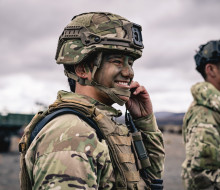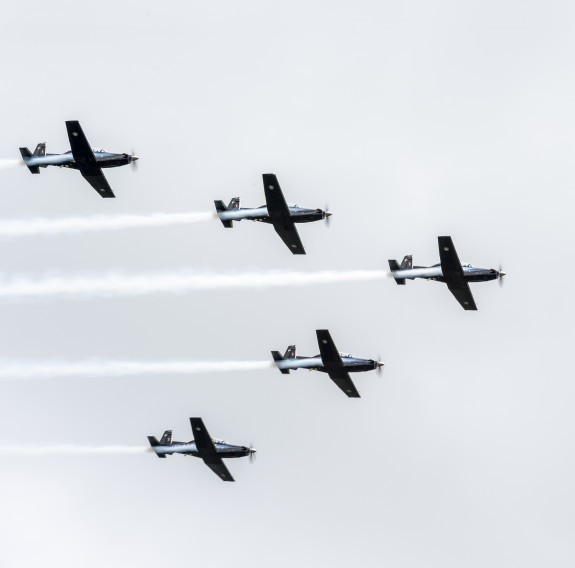
Keeping skills alive in transfer to Reserve Force
05 July 2024
Unfortunately you are viewing this website on an outdated browser which does not support the necessary features for us to provide an adequate experience. Please switch to a modern browser such as latest version of Google Chrome, Mozilla Firefox, Apple Safari or Microsoft Edge.
Ngā mihi nui
Squadron Leader Hamish Reichardt joined the Royal New Zealand Air Force (RNZAF) in 2006. He's currently one of two Flight Commanders at No. 14 Squadron and is Falcon 3 in the RNZAF Black Falcons aerobatic display team.
When did you join the RNZAF and why?
I joined in January 2006. I had wanted to join the RNZAF since I was in primary school, mainly triggered by seeing Skyhawks fly over our farm fairly regularly.
Where are you from?
I was born in Rotorua, and grew up on a farm in Rerewhakaaitu (south of Rotorua). I went to Lake Rerewhakaaitu Primary School, then John Paul College in Rotorua.
What is your role and what is an average day for you?
I am one of two Flight Commanders at No. 14 Squadron. My day consists of a mixture of meetings, personnel management, course planning and scheduling for pilots under training, flying instruction, personnel currency flying, Black Falcons training or displays. Largely I have a loose plan of how the day will unfold, and deal with the operational challenges as they come in. No day turns out as initially planned.
Do you have any relatives currently or previously serving in the NZDF?
I have an uncle who previously served in the RNZAF. He was a navigator, primarily with No. 40 Squadron.
Where have you deployed?
I’ve done two tours of Afghanistan in Helmand province while on exchange with the Royal Air Force (RAF) flying Chinook helicopters, that was in 2013-2014.
I’ve been on many exercises with No. 3 Squadron, No. 14 Squadron and with No. 18B Squadron RAF (during a three-year exchange tour between 2012 and 2015). These exercises have taken me to the USA, Jordan, two transits from England to Jordan across Europe (France, Italy, Greece, Cyprus, Israel), Vanuatu, Samoa, New Caledonia, Australia and throughout New Zealand.
Highlight of your career (apart from being a Black Falcon)?
My exchange tour with the RAF, specifically the chance to deploy on operations with them.
What’s the best thing about being an Air Force pilot?
The variety mainly. Also, the opportunity to be involved in a unique flying environment, often in very challenging conditions, to achieve extremely worthwhile outcomes (search and rescue, flood/earthquake zone evacuation, battlefield casualty recovery). In my career I have not been in the same job or flying role for more than two to three years.
Squadron Leader Hamish Reichardt flying with the RNZAF Black Falcons (far right aircraft).
Squadron Leader Hamish Reichardt

Squadron Leader Hamish Reichardt flying with the RNZAF Black Falcons (far right aircraft).
What do you do outside of work to switch off?
I don’t have hobbies as such, but my spare time is spent investing in friends and family time. Our lifestyle block also has an endless list of to-do’s.
Before a flight, do you have a personal ritual you do, either a mental thing or a routine?
Not specifically a ritual, but the more complicated trips require a lot of forethought, planning and visualisation before execution. Time spent on the ground planning reduces the surprise factor airborne.
What is something that’s really ingrained in you as a pilot?
The part I miss the most when I haven’t been airborne for a while is the view - seeing the world from a bird's eye view.
What is the aerial manoeuvre that is a bit more testing than the others?
It’s called the gyroscope, which is a three-aircraft line astern barrel roll, followed by a near 360-horizontal orbit in which we change formation to echelon right before we pass the crowd. I am at the back of the formation for this, and for most of the manoeuvre I am using the maximum engine performance of the Texan. This manoeuvre is all about timing. A slight delay in application or hesitation during the pitch up results in me dragging as I have no more power available for overtake.
When you’re travelling to the display by air, do you chat over comms?
If the flight contains a transit followed by a display, we are generally fairly quiet. Pre-positioning, or after the display there is a bit more chat but most of that is saved for after landing. It’s not being strict as such, but we are focused on achieving the job at hand.
How much talk is there over comms during the aerial routine?
During the routine each manoeuvre is called by the formation leader at the time using short phrases, for example “descending for loop.” This is done by Falcon 1 and Falcon 4, for the most part. Some of these calls require a response, but most just cue the manoeuvres. Personally I have very little to say, my job is to just be there.
What is the Texan like to fly?
The Texan has a lot of power and is fairly responsive, making it an ideal platform for us to train military pilots in. The learning curve is quite steep initially, although simulation helps with this. A combination of modern technology and experience means that once you have a bit of time in them, they are pretty easy to fly.
To get the best performance from the Texan, you have to….?
Treat the aircraft with respect. You do your planning and preparation and it’ll reward you with unique experiences.
Want to see the RNZAF Black Falcons perform this season, visit their display schedule here for more information.